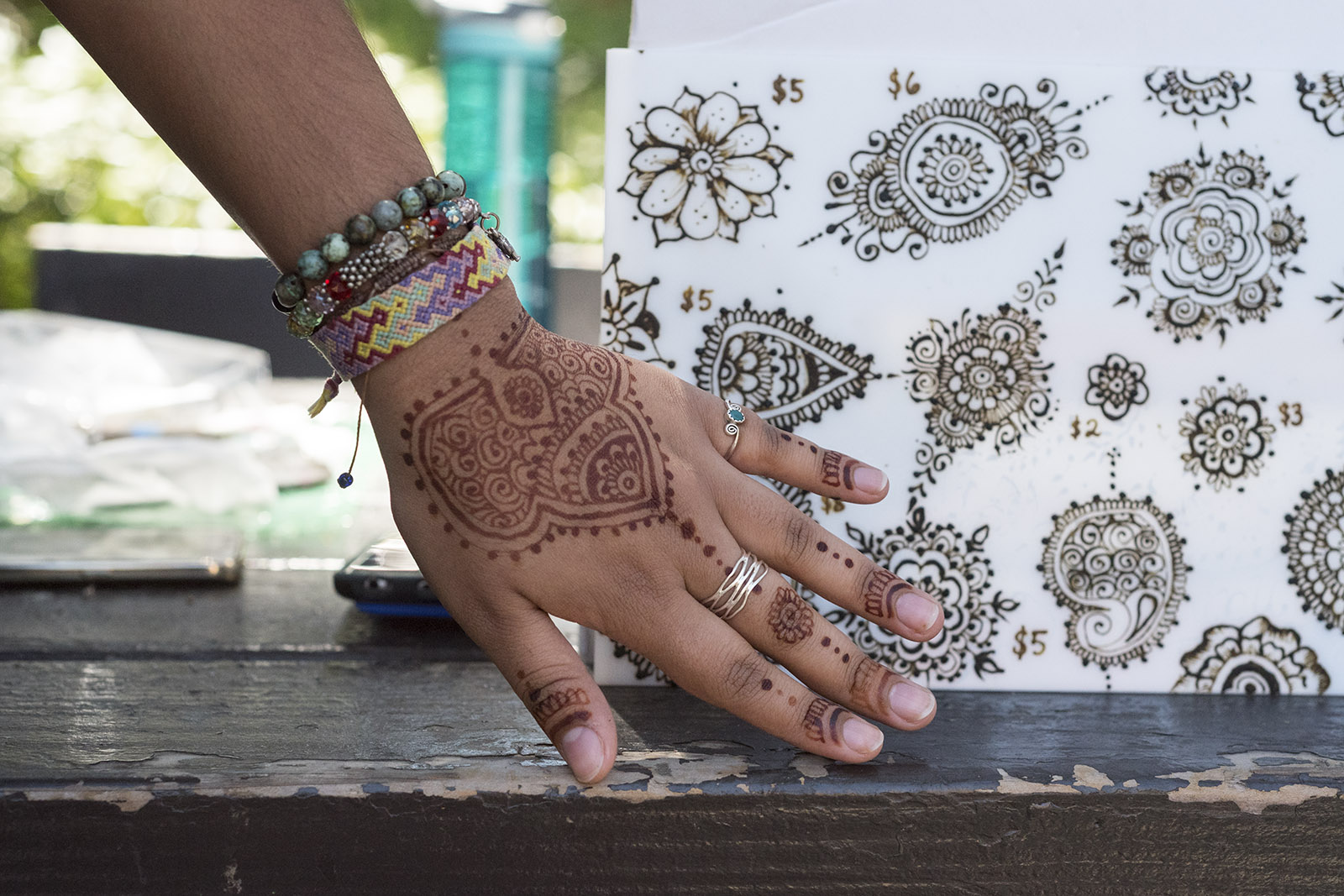Brown and Bothered: Henna appropriation cherry-picks beauty while ignoring people, culture

A South Asian student wears henna on Bruin Walk. Henna is worn traditionally during special events like weddings and religious ceremonies in South Asian culture.
(Esmeralda Lopez/Daily Bruin)
By Sidra Rashid
April 4, 2017 10:30 p.m.
Obvious reasons to avoid cultural appropriation – it involves stealing what is considered the beautiful aspects of another culture without respect for the tradition from which it originates and ignores the racism and xenophobia the creators of these items face. In Brown and Bothered, columnist Sidra Rashid discusses her experiences with appropriation of her Desi culture.
I remember walking along the Santa Cruz Beach Boardwalk one summer day, passing huddled booths and pushcarts, filled with everything from games to funnel cakes. A recent addition to the pathway was a henna booth, filled with non-South Asian people inking the thick, dark brown paste on other non-South Asian people, getting designs like floral patterns and mandalas.
Henna is art, involving detailed patterns and elaborate floral designs. However, unless you come from a country that adorns henna as part of its traditional practice, there is no reason to wear henna. Not only is it disrespectful to South Asian traditions, but also lacks sensitivity for the systematic racism and appropriation we face.
Traditionally, henna is reserved for special events, including weddings and religious celebrations – not do-it-yourself projects purchased at hipster bookstores.
Often, the action of wearing henna takes the beauty and ignores the people and their history – in this case, the racism toward Desi people and our culture.
In elementary school, my so-called friends made jokes when I came to school with henna on my hands. Some popular quips were that I never washed my hands, or I drew all over myself with brown marker. These bled into notions of who I was and what my culture is.
One girl even called me odd phrases that she thought sounded similar to the word “Pakistani,” her favorite of which was “Pocket-nadian,” whatever that means. Though the comments were not always mean-spirited, this feeling of ridicule of my cultural identity, from my decorated hands to the name of my family’s country, jolted my comfort in my identity. At the time, I thought that these words were harmless, maybe even funny. But now I realize that this casual racism did affect me as a 9-year-old girl.
I became self-conscious about wearing henna because it shouted my culture to the world a little too loudly for my taste – for weeks at a time. For a couple years, I tried to avoid my other Desi friends’ moms and their henna cones before upcoming events like engagement parties, because I was embarrassed of what people would think. The stigma I attributed to the designs made me lose sight of their beauty.
While it took me years to gain back my confidence and love for my traditions, non-Desi people in Western society have decided to define the beauty for their needs. What they once thought of as peculiar, they have now made into a trend for themselves.
I’ve seen black, Latino and Central Asian people wearing henna, perhaps thinking that because they’re people of color, it’s okay for them to wear the patterns as opposed to white people. I don’t agree. My brown and Asian peers added to the shame I felt when they made faces at my henna in elementary school – they perpetuated this casual racism too.
Unlike removable items like clothing or jewelry, henna is a temporary tattoo, usually staying on one’s skin for at least a week at a time. This is a lasting semblance of Desi culture, remaining a symbol of stolen culture for far longer. The practice of adorning henna can also disrespect a larger amount of people you come in contact with during this time frame.
After years of feeling uncomfortable to wear henna for its intended purpose, it’s hurtful to see the same people who turned their noses at my henna getting henna dolphins tattooed at boardwalks. My culture has become a way for people to feel cultured by taking a bit of my heritage and masking it with a facade of appreciation or solidarity.
You can’t wear henna and not care about South Asian people.
Between November 2015 and November 2016, there have been 140 reported acts of hate violence against South Asian, along with Muslim, Middle Eastern, Hindu, Sikh and Arab people. It seems like henna is loved and accepted more than the people it came from. A majority of the people wearing henna designs are likely not standing in solidarity against these hate crimes. You cannot take the beautiful and ignore the ugly.
I understand there are people who have worn henna without ill intentions, not understanding their actions. We have all likely done things out of ignorance that we regret. However, once you become educated, once your friend tells you they’re not comfortable with your adornment of henna – once you read this article – there is only one thing you can do: Listen.
You cannot define what upsets a group you are not a part of. You must hear the words of the Desi people around you, and process what they are saying. At this point, if you continue to wear henna, you are blatantly ignoring one’s personal feelings for your short-lived aesthetic.

